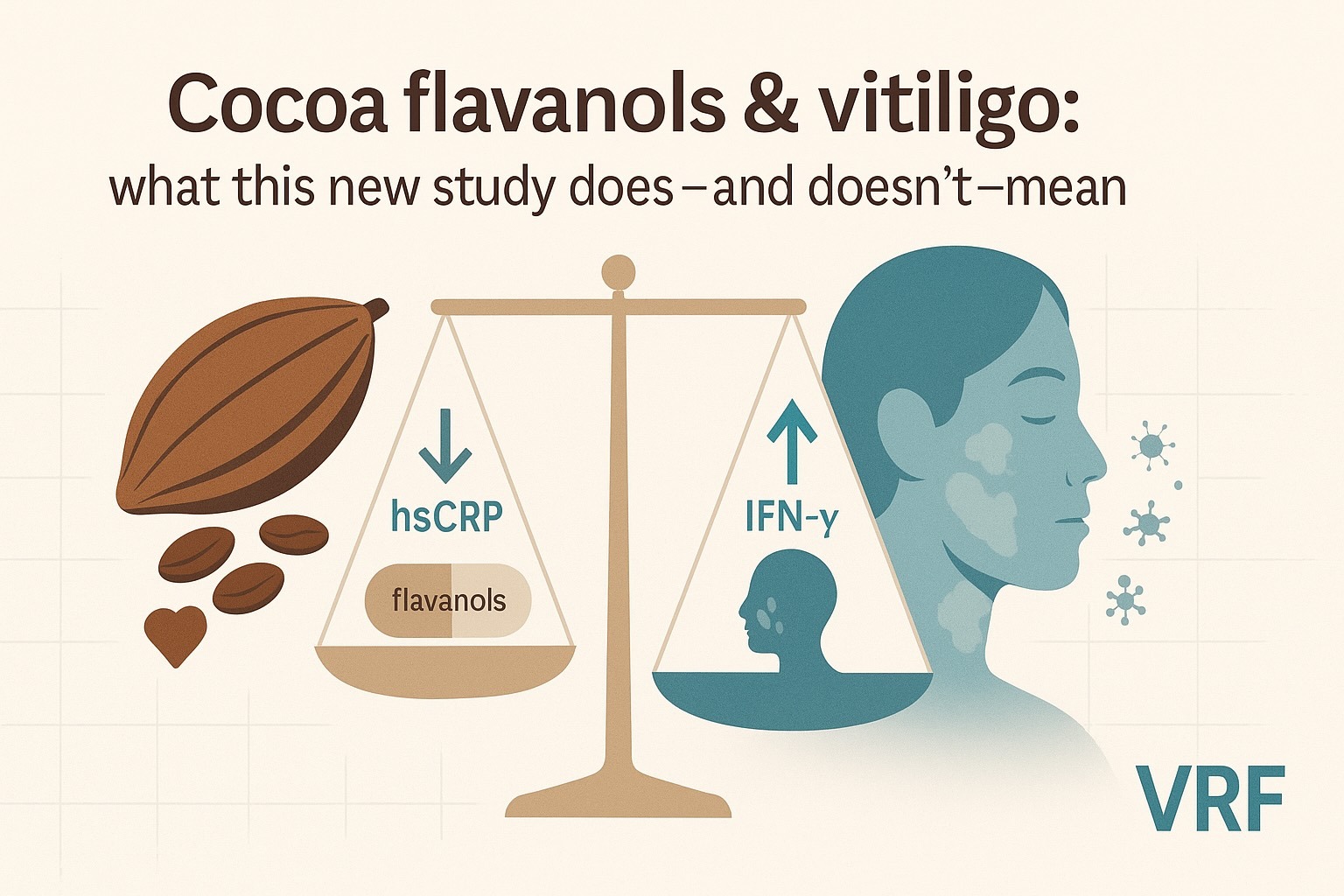New
Chocolate and Vitiligo. What This New Study Does—and Doesn't—Mean
You’ve probably seen wellness blogs cheering a study on chocolate to “lower inflammation” and promote “healthy aging.” Great headline, not much nuance. Almost no one asked: what if you’re older with other conditions, like vitiligo?
Quick Take
- This was a study in older adults looking mainly at heart – not skin health.
- The cocoa extract lowered a general inflammation marker in the blood (hsCRP) modestly and raised another immune signal called interferon‑gamma (IFN‑γ) modestly.
- For vitiligo, that IFN‑γ bump points the wrong way. IFN‑γ is the primary driver that calls in immune cells to attack pigment-producing melanocytes.
So please don't take chocolate or cocoa flavanols hoping to "treat" vitiligo, — just enjoy it responsibly.
What the Study Actually Tested
A standardized cocoa extract (not chocolate bars) taken daily for two years by people around 70 years old. The supplement contained 500 mg of cocoa flavanols including 80 mg of epicatechin. Compared with placebo, their hsCRP went down by 8.4%, and their IFN‑γ went up by 6.8%. Other inflammation signals didn't move significantly.
Why the Interferon‑Gamma Matters in Vitiligo
Vitiligo is an autoimmune skin condition where IFN‑γ is one of the main "go" signals in the immune attack. It helps recruit the very CD8+ T cells that target pigment cells and creates a positive feedback loop that worsens the autoimmune response. Many modern treatments like topical ruxolitinib specifically try to quiet this pathway. So even a small rise in IFN‑γ isn't something we'd chase on purpose for vitiligo.
About Those Skin Claims
You might read that cocoa flavanols moisturize skin, boost elasticity, or protect against sun. The science here shows modest benefits for photoprotection — some studies found that high‑flavanol chocolate consumption can increase minimal erythema dose (the amount of UV needed to cause reddening). One study showed the protective effect doubled after 12 weeks, while another found more mixed results.
However, this photoprotective effect could complicate phototherapy. If you're on NB‑UVB treatment, cocoa flavanols might make your skin more UV‑resistant, potentially requiring dose adjustments. Either way, skin photoprotection has nothing to do with repigmenting vitiligo.
So…Should I Take Cocoa Flavanols?
- Active or spreading vitiligo: better to skip high-dose cocoa supplements for now. We don’t have vitiligo-specific safety data, and IFN-γ went up.
- Stable vitiligo and you’re considering cocoa for heart reasons: talk to your doctor first. If you start, keep an eye on your skin and stop if new spots appear.
- Kids and younger adults: this study doesn’t apply. Don’t use it as a reason to start.
If you’re on phototherapy
High-flavanol products may make some people a bit more UV-resistant. If you’re on NB-UVB, tell your dermatologist before starting any new supplement. Your UV dose might need a small tweak.
"Can I Just Eat Dark Chocolate?"
Nice try. The study used a flavanol‑standardized extract. Regular dark chocolate contains much lower and variable amounts of flavanols due to processing. You'd need unrealistic amounts of chocolate to match the study dose – and you'd also get sugar, calories, and caffeine. If you and your doctor decide to try flavanols, choose a standardized product with verified content and stick to the label.
Better Bets for Vitiligo Health
- The big wins are still medical: NB‑UVB, topical ruxolitinib where appropriate, and the plan your dermatologist sets.
- Basics matter: sleep, nutrition, and movement all help your immune system behave better.
- Vitamin D: worth checking and correcting if low – deficiency is common in vitiligo patients.
- Evidence‑based adjuncts: Ginkgo biloba has shown promise in clinical trials for arresting disease progression (80% vs 36.6% with placebo) and improving repigmentation. Vitamin B12 plus folic acid combinations have demonstrated mild benefits when combined with phototherapy.
- Antioxidant combinations: Some studies show vitamin E supplementation with NB‑UVB leads to superior clinical outcomes — 72.7% vs 55.6% of patients achieved ≥51% repigmentation. Multi‑antioxidant pools including vitamin C, E, and α‑lipoic acid showed 47% vs 18% achieving ≥75% repigmentation, but the evidence is mixed and inconclusive.
- Minerals: don't megadose zinc or copper unless your tests show you're low. Not for everyone – don’t self-medicate.
Bottom Line
Cocoa flavanols may be heart‑friendly for some people, but they're not a vitiligo treatment – and the small rise in IFN‑γ makes us cautious. The photoprotective effects could also interfere with phototherapy. If you're curious for non‑skin reasons, loop in your dermatologist, especially if you're on phototherapy, and watch your skin closely.
Unlike some supplements with promising vitiligo‑specific research like ginkgo biloba or B12/folic acid combinations, cocoa flavanols lack safety data in autoimmune skin conditions and may theoretically worsen immune activity through IFN‑γ pathways.

Yan Valle
Professor h.c., CEO VR Foundation | Author A No-Nonsense Guide To Vitiligo
This article is for education, not medical advice. Your situation is unique – always talk with your dermatologist before starting any supplement.
Dig deeper:
- Diet for Vitiligo: Eating for Skin Health
- Diet, Microbiome, and Vitiligo: Unveiling the Mystery
- Nutrients for Vitiligo — Same Old Story or New Hope?
Or listen to podcast Deep Dive In Vitiligo:
- Why You’re Sleepy After Lunch and What It Means For Vitiligo (Ep. 46)
- Vitiligo and Vitamins. Hope or Hype? (Ep. 30)
- The Vitiligo Diet: Can What You Eat Heal Your Skin? (Ep. 5)
Our podcast is available on all digital platforms, like Apple Podcasts, Spotify, Amazon, YouTube Music, Podcast Addict, iHeart and elsewhere.

FAQOther Questions
- Is it possible to stop the progression of vitiligo?
While it's not always possible to quickly stop vitiligo progression, there are some treatments that can help slow or halt the spread of the condition in many cases: Corticoster...
- How to get insurance coverage for vitiligo treatments?
Getting insurance coverage for vitiligo treatments can be challenging, but there are several steps you can take to improve your chances For a more in-depth look, check out our ...
- Can Ginkgo Biloba help with vitiligo?
Ginkgo Biloba offers a promising, simple, and relatively affordable option for managing vitiligo. Known for its anti-inflammatory, immunomodulatory, and antioxidant properties, ...
Though it is not always easy to treat vitiligo, there is much to be gained by clearly understanding the diagnosis, the future implications, treatment options and their outcomes.
Many people deal with vitiligo while remaining in the public eye, maintaining a positive outlook, and having a successful career.
Copyright (C) Bodolóczki JúliaBy taking a little time to fill in the anonymous questionnaire, you can help researchers better understand and fight vitiligo.
